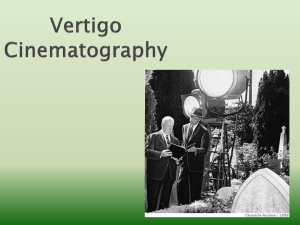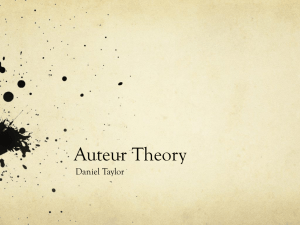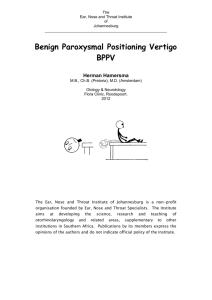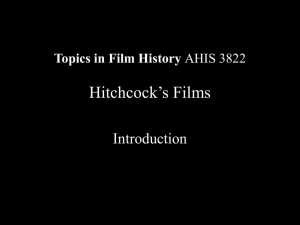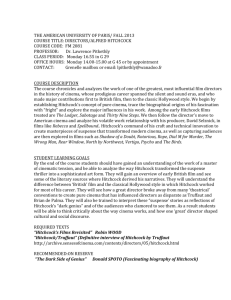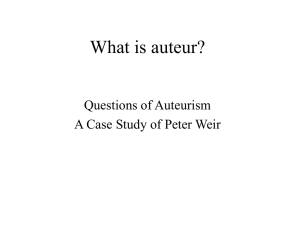Vertigo - Hinchingbrooke
advertisement
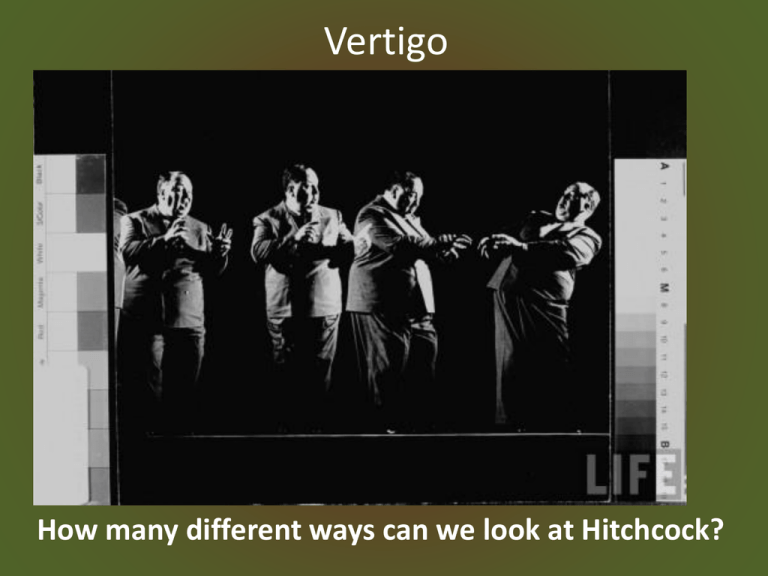
Vertigo How many different ways can we look at Hitchcock? Critical response to Vertigo The general consensus of reviews in 1958 was that ‘Vertigo’ is ‘too slow and too long’, which contrasts with today’s general view of ‘Vertigo’, with Rotten Tomatoes giving it a 98% ‘Fresh’. Some of the ways we can look at Vertigo: • Auteur theory • Feminist perspective • Psychoanalytical perspective Auteur Theory In the 1950s, Hitchcock was seen as a ‘showman’ – a good entertainer, rather than as a serious artist. Auteur Theory Francois Truffaut championed Hitchcock as a great artist. Truffaut considered the director to be the source of meaning in films. Thus, we can define themes, style and cinematic invention across Hitchcock’s whole output, including Vertigo. Auteur Theory Using auteur theory, we can analyse how Vertigo is characteristic of Hitchcock’s concerns, both thematic and stylistic. There’s something about Stairs going on… Auteur Theory Auteur theory is debated, largely due to the fact that film is a collaborative process but Hitchcock’s ‘stamp’ is so clear that he is generally recognised as an auteur. Auteur Theory Revise the approaches of: • Francois Truffaut • Andre Bazin Three critics who debate auteur theory generally, rather than directly discuss Vertigo • Ian Cameron • Andrew Sarris • Roland Barthes Feminist Perspective Feminist Perspective There are two threads that we have discussed: • The way Vertigo represents women through a masculine viewpoint. (Laura Mulvey) • Vertigo as an exploration of masculine identity crisis. (Tania Modleski) Feminist Perspective Laura Mulvey in brief: • Vertigo is a film about the act of looking – ‘the look is central to the plot’ • We are made to identify with the male subject at the expense of the female object • The female is coded with ‘to-be-looked-at ness’ How are we led to identify with Scottie? • • • • • Scottie dominates the narrative – for much of the film, we know what he does James Stewart was a popular actor, known for his approachable characters The use of shot-reverse shot makes us directly engage with his perception He seems to fulfil the traditional masculine role of the heroic investigator – a role we ‘recognise’ as audiences and identify with He is the subject of the narrative – it is his story and he seems to be the one who drives the story How is Judy/Madeleine coded? • • • • • Kim Novak: a young, attractive actress Use of colour and costume Composition and lighting Cinematography The character knows more than we do, making her less accessible in the early scenes • She is the object of the narrative – the thing that Scottie is trying to reach Feminist Perspective • Tania Modleski in brief: • Scottie is a man in search of a lost masculine identity • Masculine identity is defined through dominance over an idealised female identity • Revealing this dominance as an illusion leads to violence against women Tania Modleski: ‘The Women who knew too much’ ‘Men’s fascination and identification with the feminine continually undermines their effort to achieve a masculine strength and autonomy and is a primary cause of a violence towards women that abounds in Hitchcock’s films.’ The image of femininity in the film is shown as a male construct. • BUT: If the feminine, against which the masculine defines himself, is nothing, what, if anything, is he? • Therefore, Vertigo is about the illusion/construction of masculine identity as much as it is about the construction of feminine appearance. • The film addresses the nature of looking, manipulation and illusion – something fundamental to cinema and spectatorship. • The ‘demasculinising’ scenes with Midge Elster is portrayed in ways that foreground his masculinity – another illusion as his position has been gained through marriage Psychoanalytic Perspective Two main perspectives: Donald Spoto – Vertigo is an insight into the workings of Hitchcock’s subconscious J. L. Baudry – Considers that we as an audience use cinema to stimulate ourselves through fantasy: we allow another to dream for us Donald Spoto states that without considering this psychological profile, it is not possible to make sense of Hitchcock’s films or of the sources of Hitchcock's creativity. J.L Baudry “What is, then, the desire at work behind the long history of the cinema," if not that of "producing a simulation machine capable of presenting the subject with perceptions having the characteristic of illusions of reality, of hallucinations, of dreams"? So, according to this perspective, Hitchcock is using the mechanics of cinema to stimulate our subconscious minds, not reveal his own. Apparatus Theory Baudry maintains that cinema is by nature ideological because its mechanics of representation include the camera and editing. The central position of the spectator within the perspective of the composition is also ideological. • Apparatus theory also argues that cinema maintains the dominant ideology of the culture within the viewer. Ideology is not imposed on cinema, but is part of its nature. Does that mean…? Yes, Apparatus Theory does fit in with Feminist theory if we agree that the dominant ideology of society is sexist. So we can see Hitchcock from multiple perspectives


